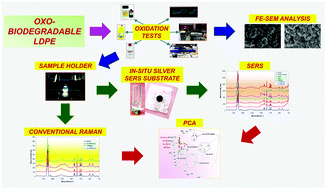Fast assessment of oxo-biodegradable polyethylene film oxidation by surface-enhanced Raman scattering with in situ formation of a silver nanoparticle substrate
Abstract
For the first time, a silver nanoparticle substrate has been generated in situ through a cheap chemical reaction directly on a flexible polyethylene surface. Then, fast assessment of oxidation of an oxo-biodegradable polyethylene film has been carried out by means of surface-enhanced Raman scattering (SERS), achieving enhancement factors up to 3.2 × 105. Prior to the silver layer deposition, polymeric samples were exposed to different oxidation agents: ultraviolet light, heat, chemical oxidants and OH˙ radicals. The influence of oxidation treatment on the size and shape of silver nanoparticles was studied by scanning electron microscopy. Principal component analysis was performed and 85.4% of the accumulated variance was explained with three components, showing clear discrimination among oxidized samples after only 48 hours. However, conventional Raman spectroscopy was unable to find any difference. The proposed SERS method is able to detect significant oxidative changes in the polymer from 3 to 10 hours, considerably shorter than other techniques, such as FTIR, that require at least 10 days, and can be used for screening purposes or as an excellent complement to other analytical techniques.



 Please wait while we load your content...
Please wait while we load your content...